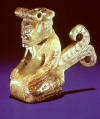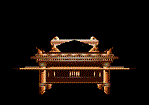|

by David Hatcher
Childress
from
UfoEvidence Website
Like a real life Indiana Jones, maverick archeologist David
Hatcher Childress has taken many incredible journeys to some of
the oldest and most remote spots on earth. Writing prolifically of
lost cities and ancient civilizations, he has produced no less than
six lengthy books (the Lost Cities series) chronicling the dimly
remembered glories of obscure locales from the Gobi desert
to
Puma Punku in Bolivia, from Mohenjo Daro
to
Ba'albek. We caught up with him shortly before taking
off for New Guinea on yet another archeological expedition and asked
him if he would be willing to write an exclusive for Atlantis Rising
on the Top 10 Ancient Civilizations with Advanced Technology.
He agreed to dig through his archives and give us a story. ED
1.
ANCIENT MU OR LEMURIA
According to various esoteric sources, the first civilization arose
78,000 years ago on the giant continent known as
Mu
or
Lemuria and
lasted for an astonishing 52,000 years. It is sometimes said to have
been destroyed in earthquakes generated by a pole shift which
occurred some 26,000 years ago, or at approximately 24,000 B.C.
While Mu did not reach as high a technology,
supposedly, as other later civilizations, it is, nevertheless, said
to have attained some advanced technology, particularly in the
building of long-lasting megalithic buildings that were able to
withstand earthquakes. However, it was the science of government
that is sometimes said to have been Mu's greatest
achievement.
Supposedly, there was one language and one government. Education was
the keynote of the Empire's success, and because every citizen was
versed in the laws of the universe and was given thorough training
in a profession or trade, magnificent prosperity resulted. A child's
education was compulsory to the age of 21 in order for him to be
eligible to attend citizenship school. This training period lasted
for seven years; so the earliest age at which a person could become
a citizen of the empire was 28.
2.
ANCIENT ATLANTIS
It is said that when the continent of Mu sank, the
oceans of the world lowered drastically as water rushed into the
newly formed Pacific Basin. The relatively small islands which had
existed in the Atlantic during the time of the Lemurian
civilization were left high and dry by the receding ocean.
The newly emerged land joined the Poseid Archipelago of the Atlantic
Ocean to form a small continent. This continent is called
Atlantis by historians
today, though
its real name was Poseid.
Atlantis is believed to have taken technology to very
advanced stages, well beyond what exists on our planet today. In the
book A Dweller On Two Planets, first dictated in 1884 by
Phylos the Thibetan to a young Californian named Frederick
Spencer Oliver, as well as in a 1940 sequel, An Earth Dweller
Returns, there is mention of such inventions and devices as air
conditioners to overcome deadly and noxious vapors; airless cylinder
lamps, tubes of crystal illuminated by the night side forces;
electric rifles, guns employing electricity as a propulsive force
(rail-guns are similar, and a very new invention); mono-rail
transportation; water generators, an instrument for condensing water
from the atmosphere; and the Vailx, an aerial ship
governed by forces of levitation and repulsion.
The sleeping clairvoyant,
Edgar Cayce, in a reading spoke
of the use of airplanes and of crystals or firestones used for
energy and related applications. He also speaks of the misuse of
power and warnings of destruction to come.
3.
RAMA EMPIRE OF INDIA
Fortunately, the ancient books of India's
Rama
Empire have been preserved, unlike those of
China, Egypt, Central America, Peru. Many of these ancient nations
are now either desert wastelands, swallowed by thick jungle or
literally at the bottom of some ocean. Yet India, despite
devastation by wars and invasion, managed to maintain a large part
of its ancient history.
|

Mohenjo Daro |
For a long time, Indian civilization was not believed to date
from much earlier than about 500 B.C., only about 200 years
prior to
Alexander the Great's invasion of the subcontinent. In the
past century, however, the extremely sophisticated cities of
Mohenjo
Daro
(Mound of the Dead) and Harappa have been
discovered in the Indus Valley of modern-day Pakistan.
The discoveries of these cities forced archaeologists to push the
dates for the origin of Indian civilization back thousands of years.
A wonder to modern-day researchers, the cities were highly developed
and caused leading archaeologists to believe that they were
conceived as a whole before they were built: a remarkable early
example of city planning. Even more remarkable is that the
plumbing-sewage system throughout the large city is superior to that
found in Pakistan, India, and most Asian countries today.
4.
OSIRIAN CIVILIZATION OF THE MEDITERRANEAN
It is said that at the time of Atlantis and Rama,
the Mediterranean was a large and fertile valley. This ancient
civilization,
pre-dating dynastic Egypt, was known as the Osirian
Civilization.
The Nile river came out of Africa, as it does today,
and was called the River Stix.
|

Malta |
However, instead of flowing into the Mediterranean Sea at the
Nile Delta in northern Egypt, it continued into the valley, and
then turned westward to flow in the deepest part of the
Mediterranean Valley where it created a large lake and then
flowed out between Malta and Sicily,
and south of Sardinia into the Atlantic at Gibraltar (the
Pillars of Hercules). When
Atlantis was destroyed in a cataclysmic upheaval,
this cataclysmic change in the Atlantic slowly flooded the
Mediterranean Basin, destroying the
Osirian's great cities and forcing them to move to
higher ground. This theory helps explain the strange megalithic
remains found throughout the Mediterranean.
It is an archaeological fact that there are more than 200 known
sunken cities in the Mediterranean. Egyptian civilization, along
with the Minoan and Mycenean in Crete
and Greece are, in theory, remnants of this great, ancient culture.
The civilization built huge earthquake-proof megalithic structures
and had electricity and other conveniences common during the time of
Atlantis. Like Atlantis and Rama, they had airships and
other modes of transport, often electrical in nature. The mysterious
cart tracks of Malta, which go over cliffs and under water,
may well be part of some ancient Osirian tram-line,
possibly taking quarried stone to cities that are now submerged.
Probably the best example of the high technology of the
Osirians is the amazing platform found at Ba'albek,
Lebanon. The main platform is composed of the largest hewn rocks in
the world, the famous
ashlars of Ba'albek. Some of the individual
stones are 82 feet long and 15 feet thick and are estimated to weigh
between 1,200 and 1,500 tons each!
5. UIGER CIVILIZATION OF THE GOBI DESERT
Many ancient cities are said to have existed at the time of Atlantis
and Rama in the Uiger civilization of the Gobi
Desert.
|

Gobi desert
(aerial view) |
Though the Gobi is now a parched land-licked
desert, these cities were ocean ports.
Edgar Cayce once said that elevators would be
discovered in
a lost city in the Gobi Desert, and while this has
not happened yet, it is not out of the question.
Vimanas
and other advanced devices are said to have been in use in the
Uiger area, and the famous Russian explorer Nicholas
Roerich
reported seeing a flying disc over northern Tibet in the 1930s.
Perhaps the craft was an ancient vimana coming
from a still active city using Uiger technology
that exists in Northern Tibet or the
Gobi Desert.
Significantly, it is claimed that the Elders of Lemuria,
known as
the Thirteenth School, moved their headquarters prior
to the cataclysm to the uninhabited plateau of Central Asia that we
now call Tibet. Here they supposedly established a library and
school known as
The Great White Brotherhood.
For instance, the great Chinese Philosopher Lao Tzu, born in
604 B.C., talked frequently of Ancient Masters and their profound
wisdom. He wrote the famous book, Tao Te Ching,
probably the most popular book ever written in Chinese. When he
finally left China, near the close of his very long life, he
journeyed to the west to the legendary land of Hsi Wang Mu.
According to the ancient Chinese, this was the headquarters of
the Ancient Ones. Could this have been
The Great White Brotherhood and the Thirteenth
School of Mu?
6.
TIAHUANACO
As in Mu and Atlantis, construction in
South America was on megalithic scale with polygonal construction
techniques designed to make the massive walls earthquake-proof.
Earthquake-resistant walls were important all around the
Ring-of-Fire, ancient Mu.
Homes and communal buildings were built out of megalithic blocks of
stone. Because of the high regard the culture had for the well being
of future generations and the value they placed upon the gradual,
sustained growth of the community, structures were built to last for
thousands of years. A house built of cement, wood and plaster-wall
will last a hundred years or so, if kept up. Witness the megalithic
construction of Egypt, Malta, Peru. These buildings are still
standing today. Cusco, the ancient capital of Peru,
which was probably built before the Incas, is still
inhabited today after thousands of years. Indeed, most of the
buildings of downtown Cusco today incorporate walls that are many
hundreds of years old (whereas more recent buildings constructed
by the Spanish are already crumbling).
|

Puma Punku |
Only a few hundred miles to the south of Cusco lie the fantastic
ruins of Puma Punku, high in the Altiplano of
Bolivia. The ruins of Puma Punku, about one mile from the famous ruins
of
Tiahuanaco, are massive megalithic constructions
that are tossed about like toy building blocks. What kind of
cataclysmic upheaval could have done such a thing? Here is the
kind of megalithic construction meant to last for thousands of
years, yet, the 100-ton blocks have been torn asunder by mighty
geological forces.
It would appear that the South American continent was suddenly and
violently thrust upward during some kind of cataclysm, most likely a
pole shift. A former sea-level canal can now be seen at 13,000 feet
in the Andes Mountains. As possible evidence for this
scenario, many ocean fossils can be found near Lake Titicaca. The
lake is even inhabited by the only known fresh water sea horses.
7. THE MAYANS
|

Uaxactun |
Mayan pyramids are found from Central America to as far away as the
Indonesian island of Java. The pyramid of Sukuh, on
the slopes of Mount Lawu near Surakarta in central Java is an
amazing temple with stone stelae and a step pyramid that
would match any in the jungles of Central America.
The pyramid is in fact virtually identical to the pyramids found
at the ancient Mayan site at Uaxactun,
near
Tikal.
The ancient Mayans were brilliant astronomers and
mathematicians whose early cities lived in agrarian harmony with
earth. They built canals and hydroponic garden cities throughout
the ancient Yucatan Peninsula.
Some of the Mayan glyphs were allegedly radionic-type insect
control devices that broadcast an etheric vibration of the
targeted pest.
Edgar Cayce mentions the Mayas and their technology in one
reading: As for a description of the manner of construction of the
stone: we find it was a large cylindrical glass (as would be termed
today); cut with facets in such manner that the capstone on top of
it made for centralizing the power or force that concentrated
between the end of the cylinder and the capstone itself. As
indicated, the records as to ways of constructing same are in three
places in the earth, as it stands today: in the sunken portion of
Atlantis, or
Poseidia, where a portion of the temples may yet be
discovered under the slime of ages of sea water, near what is known
as
Bimini, off the coast of Florida.
And (secondly) in
the temple records that were in Egypt, where the entity acted later
in cooperation with others towards preserving the records that came
from the land where these had been kept. Also (thirdly) in records
that were carried to what is now Yucatan, in America, where these
stones (which they know so little about) are now, during the last
few months, being uncovered.
It is believed that an ancient Hall of Records resides
somewhere in the Mayan region, probably beneath an existing pyramid
complex, in an underground tunnel and chamber system. Some sources
say that this repository of ancient knowledge is kept in quartz
crystals that are of exceptional quality and capable of holding
large amounts of information in the similar manner as a modern CD.
8. ANCIENT CHINA
|

Shang Chinese
jade |
Ancient China, known as Han China, is said to have
come, like all civilizations, from the huge Pacific continent
Mu. The ancient Chinese are known for their sky-chariots,
their geomancy, and the jade manufacture that they shared with the
Mayas. Indeed, the ancient histories of the Chinese and the Mayas
seem indelibly linked.
Anthropologists makes a good case for a Taoist influence coming
to Central America by showing Shang dynasty
symbols and motifs (the yin-yang is the most famous, but there
are many more) and then relating them to known Mayan art
and sculpture. Jade was of particular importance to the
Shang Chinese. So far, the source of Chinese jade has
not been pinpointed. Much of it may have come from Central
America. Even the source of Central American jade is a
mystery; many ancient jade mines are believed to be still
undiscovered.
Anthropologists suggest that Chinese voyages to
Mexico, between 500-300 B.C., may have been related to Taoist
trade in magic mushrooms or drugs of longevity.
The ancient Chinese are often said to be the originators of every
invention from toilet paper, earthquake detectors, paper money,
canons, rocket technology, printing methods, and thousands of other
clever and high-tech items. In 1959 archaeologists in China
discovered belt buckles made out of aluminum thousands of years ago.
Aluminum is generally processed from bauxite with electricity!
9. ANCIENT ETHIOPIA & ISRAEL
From such ancient texts as the Bible and
the Ethiopian book
Kebra Negast, we have tales of the high
technology of ancient Ethiopia and Israel. The temple at Jerusalem
is said to have been founded upon three gigantic ashlar blocks
of stone similar to those at
Ba'albek, Lebanon. Today, the revered Temple of
Solomon and Muslim Dome of the Rock mosque exist on this site, whose
foundations apparently reach back to the Osirian civilization.
Like much of the later Phoenician construction, the
building at the Temple to hold the Ark of the Covenant
and the temples in Ethiopia are the last of the megalithic stone
constructions. The massive
Temple Mount, built by King Solomon on the
ruins of earlier megalithic temple, was made to house the ancient
relic known as the
Ark of the Covenant.
|

Ark of the
Covenant
Press F5
in your Keyboard |
The
Ark of the Covenant is said to have been an
electrical generator box which housed several sacred objects,
including a solid gold statue from earlier cultures that is
called the Holy of Holies. This box and gold statue were said to
have been removed from the King's Chamber in the Great
Pyramid in Egypt by Moses during the period of
the Exodus.
Many scholars believe that the Ark of the Covenant,
as well as other ancient artifacts, were actually
electrical devices, some of which were worshipped in
temples as oracles.
The Bible recounts how certain unauthorized persons would touch the
Ark and be electrocuted.
10. THE AROI SUN KINGDOM OF THE PACIFIC
The last of my list of ancient civilizations is that of the
virtually unknown ancient culture of the Aroi Sun Kingdom of
the Pacific. While the so-called lost continent of Mu
sank over 24,000 years ago in a pole shift, the Pacific was later
repopulated by a racial mixture of all civilizations, coming from
Rama,
China, Africa
and the Americas.
An advanced island nation, with larger areas of land than are
currently in the Pacific, grew up around Polynesia, Melanesia and
Micronesia. Ancient legends in Polynesia attribute this remarkable
civilization to the Aroi Kingdom that existed many
thousands of years before the European rediscovery of the Pacific.
The Aroi
allegedly built many of the megalithic pyramids, platforms,
arches, roads and statues throughout the central Pacific.
|

Nan Douwas, the
island in Nan Madol from where ancient kings ruled Pohnpei |
When some of the more than 400 gravel hills on New Caledonia were
excavated in the 1960s, cement columns of lime and shell matter were
carbon dated by Yale and the New Caledonia Museum as having been
made before 5120 B.C. and 10,950 B.C. These weird cement columns can
be found in the southern part of New Caledonia and on
the
Isle of Pines.
According to the Easter Islanders, the statues of the islands
walked or levitated in order to move in a
clock-wise spiral around the island. On the island of
Pohnpei, the Micronesians claim that the stones of the
eleven-square-mile city were levitated into place.
The Polynesians of New Zealand, Easter Island, Hawaii and Tahiti
all believe that their ancestors had the ability of flight and
would travel through the air from island to island. Was this the
Air Atlantis flight that stopped in Malta, Ba'albek, and Rama
destined for the remote but popular convention center at Easter
Island?
|








